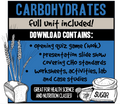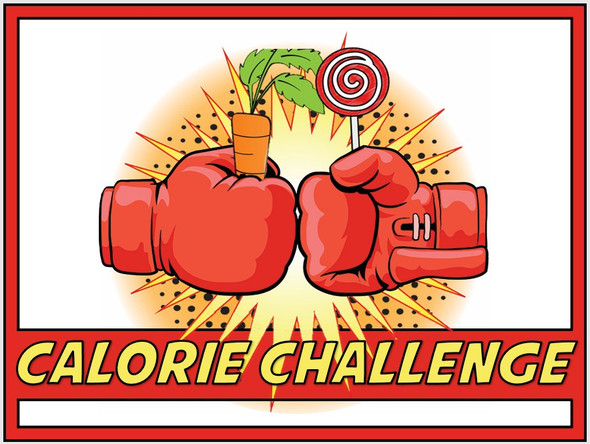Description
The unit on carbohydrates is a vital component of teaching nutrition. As one of the 3 major macronutrients and the one that is closely tied to many medical conditions and diseases, it stands to hold significant importance. This unit is very large, but I included plenty of supporting activities and worksheets that are completely optional. I have also included both written and video instructions for you to use to help you execute the lesson confidently.
I will briefly go through and describe each of the items included. However, if you have any questions on further clarification, feel free to reach out. I've also included a preview of the documents included as well as a quick look at the presentations included (click on product video tab to view)
FOOD FOR THOUGHT: opener/hook (Powerpoint/Google Slides with optional worksheet PDF to use along with game)
I use this activity as my “hook” for the unit. It is set up as a “quiz show” style game. It is set up as a PowerPoint, but I was able to convert it to a Google Slides presentation. It also comes with an optional PDF you can print and give to the students to help them follow along.
Students will be quizzed on carbohydrate related questions (ie. which of the following McDonald's sandwich contains the MOST carbs?). No prior knowledge required- just some reasoning skills and a little luck! It's a great way to get students to prepare their minds to learn about the topic.
CARBS: main presentation (PowerPoint/Google Slides)
This is your lecture slideshow and should cover your standards. Topics covered include:
-
Defining carbohdyrates
-
Structure of a carbohydrate
-
Classification of Carbohydrates
-
Monosaccharides (glucose, fructose, galactose)
-
Disaccharides (sucrose, lactose, maltose)
-
Oligosaccharides
-
Polysaccharides (starch, glycogen, fiber)
-
Artificial sweeteners
-
Sugar alcohols
-
Glycemic index/load
-
Digestion of carbohydrates
-
USDA dietary guidelines of carbohydrates
CARBS PRESENTATION NOTES PAGE (printable and fillable PDF)
This is a completely optional way to allow your students to take notes along with the Presentation. I like having notes pages because it’s great at allowing them to follow along and it does allow them to write less and listen more.
CARBOHYDRATE "FAMILY TREE) (printable and fillable PDF with answer key)
After teaching this unit for years, I started using this "family tree" handout because I feel like it helps students organize all the different types of carbohydrates in their heads. Carbs are one of the macronutrients that have so many types and I feel like this really helps to lay it out in an logical way.
SIMPLE VS COMPLEX CARBOHYDRATES WORKSHEET ((printable and fillable PDF with answer key)
While lecturing, I like to stop and do this worksheet to review simple and complex carbs. I feel like it’s one thing to learn the science behind carbohydrates, but it is also important to learn the practical nutrition side as well. This worksheet will help students see real life food examples of simple and complex carbohydrates.
MARSHMALLOW MONOSACCHARIDES (Powerpoint/Google Slides and PDF handout)
This activity is a cheap and fun way to review the structure of a monosaccharide. All it takes is a few bags of colored mini marshmallows and some toothpicks. After reviewing the structure of the 3 monosaccharides, students will construct a randomly assigned monosaccharide. Activity comes with a template for each monosaccharide as well as a presentation that will guide them through it. Also includes some additional information for learning.
JUST A SPOONFUL OF SUGAR? (PowerPoint presentation with a Teacher's Guide)
This game can be done at any time during the unit and it a practical and visual representation of the amount of sugar that can be found in the foods we eat. It comes with a PowerPoint to display when playing. It can be played in various ways, but I like to purchase sugar cubes and have students work in pairs to display how many sugar cubes can be found in that food item.
CARBOHYDRATE CALCULATIONS (printable and fillable PDF with answer key)
I have students complete this worksheet after I play the “Just A Spoonful of Sugar?” game. This is another practical application because it allows students to see the connection between grams and teaspoons as well as compare it to the AHA’s recommendations. I added in the aspect of students guessing the food item just for fun.
CARBOHYDRATE METABOLISM DISORDERS (Powerpoint/Google Slides Presentation)
This presentation is important in connecting nutrition and health. I choose to cover what I believe are the three main conditions related to carbohydrates; diabetes, lactose intolerance and celiac disease. It is a short presentation that reviews the physiology of the disorder as well as recommendations. This information will be used to complete the case study activity.
CARBOHYDRATE CASE STUDIES (printable and fillable PDF and answer key)
This activity was designed to accompany the Carbohydrate Metabolism Disorders presentation. I am a huge fan of case studies because I believe it is the best way to merge scientific knowledge with real-world health care. The case studies go over the 3 main conditions reviewed in the presentation. Students will create a meal plan for a diabetic patient, modify a recipe for a lactose intolerant person and choose items that are gluten free.
IODINE STARCH LAB: (editable Word document and Teacher's Guide)
This is a great lab for demonstrating the differences between sugars and starches. I have created instructions and ideas of ways to vary this lab and left it as a Word document so you could modify it. For this lab you will need iodine and various foods to experiment on. I provided some ideas of how to perform the lab as well as post-lab questions to ask the students.
*I was able to convert all but one of the PowerPoint presentations into a Google Slide presentation, however, there are some differences in the two upon conversion. Most of the visual effects did not transfer, but overall the appearances are very similar.
This lesson typically takes me 7-9 class days to complete if I do all of the activities included. I tried to provide as much detail as possible in the description, however, if you have questions don't hesitate to reach out!













